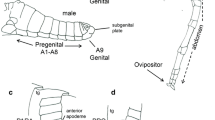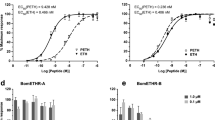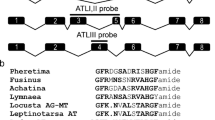Summary
-
1.
In the tobacco hornworm,Manduca sexta, the same peristalsis motor pattern is employed at both larval and pupal ecdysis (Weeks and Truman 1984). However, one prominent difference between the two behaviors is that at larval ecdysis, rhythmic extensions and retractions of the abdominal prolegs are superimposed on the peristalsis pattern. The present experiments investigated the basis of this behavioral change during the larval-pupal transformation.
-
2.
Two retractor muscles of the proleg, the principal planta retractor muscle (PPRM) and the accessory planta retractor muscle (APRM) were chosen for study (Fig. 1). PPRM is singly innervated by motoneuron PPR, while APRM is innervated by two morphologically similar motoneurons, both designated APR (Figs. 2, 3). During larval ecdysis these muscles contract rhythmically to produce proleg retractions, and their motoneurons fire synaptically-driven impulse bursts (Fig. 4).
-
3.
During the larval-pupal transformation both muscles degenerate and by pupal ecdysis they are gone (Fig. 5). At the same time motoneurons PPR and APR exhibit massive dendritic reductions (Fig. 3). PPR dies two days after pupal ecdysis while APR survives to adulthood.
-
4.
Intracellular recordings from APR and PPR during the pupal ecdysis motor pattern in deafferented preparations showed that both motoneurons were synaptically driven to fire rhythmically in the same pattern as was seen during larval ecdysis, despite their lack of target muscles (Fig. 6).
-
5.
Thus, not only was the same peristalsis motor pattern generated at both larval and pupal ecdysis, but the proleg motor pattern was conserved as well. The behavioral differences at the two stages, notably the elimination of proleg movements at pupal ecdysis, resulted solely from the elimination of the peripheral proleg musculature and was not accompanied by the removal of central synaptic inputs to the proleg motoneurons.
-
6.
To examine the possibility that the proleg motoneurons continued to participate at pupal ecdysis because they made significant synaptic connections onto other neurons (e.g., as members of the central pattern generator circuit), they were stimulated to see if their activity could either influence ongoing motor activity elsewhere in the nerve cord, or could reset the phasing of the ecdysis motor pattern. These results were uniformly negative.
Similar content being viewed by others
Abbreviations
- APRM :
-
accessory planta retractor muscle
- EH :
-
eclosion hormone
- PPRM :
-
principal planta retractor muscle
References
Copenhaver PF, Truman JW (1982) The role of eclosion hormone in the larval ecdysis ofManduca sexta. J Insect Physiol 28:695–701
Friesen WO, Poon M, Stent GS (1978) Neuronal control of swimming in the medicinal leech. IV. Identification of a network of oscillatory interneurones. J Exp Biol 75:25–43
Heitler WJ (1978) Coupled motoneurones are part of the crayfish swimmeret central oscillator. Nature 275:231–234
Hinton HE (1952) The structure of the larval prolegs of the Lepidoptera and their value in the classification of the major groups. Lep News 6:1–6
Hinton HE (1955) On the structure, function and distribution of the prolegs of the Panorpoidea with a criticism of the Berlese-Imms theory. Trans R Entomol Soc Lond 106:455–540
Hoyle G, Burrows M (1973) Neural mechanisms underlying behavior in the locustSchistocerca gregaria I. Physiology of identified motoneurons in the metathoracic ganglion. J Neurobiol 4:3–41
Kristan WB Jr (1977) Neural control of movement group report. In: Stent GS (ed) Function and formation of neural systems. Berlin, Dahlem Konferenzen, pp 329–354
Levine RB, Truman JW (1982) Metamorphosis of the insect nervous system: changes in the morphology and synaptic interactions of identified cells. Nature 299:250–252
Levine RB, Truman JW (1983) Peptide activation of a simple neural circuit. Brain Res 279:335–338
Ort CA, Kristan WB Jr, Stent GS (1974) Neuronal control of swimming in the medicinal leech II. Identification and connections of motor neurons. J Comp Physiol 94:121–154
Randall WC (1968) Anatomical changes in the neuromuscular complex of the proleg ofGalleria mellonella (L.) (Lepidoptera: Pyralididae) during metamorphosis. J Morphol 125:105–128
Reynolds SE, Truman JW (1983) Eclosion hormone. In: Downer RGH, Laufer H (eds) Insect endocrinology. A.R. Liss, New York, pp 217–233
Riddiford LM (1980) Interaction of ecdysteroids and juvenile hormone in the regulation of larval growth and metamorphosis of the tobacco hornworm. In: Hoffmann JA (ed) Progress in ecdysone research. Elsevier/North-Holland Biomedical Press, pp 409–430
Runion HI, Pipa RL (1970) Electrophysiological and endocrinological correlates during the metamorphic degeneration of a muscle fibre inGalleria mellonella (L.). J Exp Biol 53:9–24
Selverston AI, King DG, Russell DF, Miller JP (1976) The stomatogastric nervous system: structure and function of a small neural network. Prog Neurobiol 7:215–290
Taylor HM, Truman JW (1974) Metamorphosis of the abdominal ganglia of the tobacco hornworm,Manduca sexta. J Comp Physiol 90:367–388
Truman JW, Levine RB (1983) Cellular events in the nervous system during metamorphosis in the moth,Manduca sexta. In: Barker JL (ed) Current methods in cellular neurobiology, vol 4. John Wiley, pp 15–48
Truman JW, Reiss SE (1976) Dendritic reorganization of an identified motoneuron during metamorphosis of the tobacco hornworm moth. Science 192:477–479
Truman JW, Weeks JC (1983) Hormonal control of the development and release of rhythmic ecdysis behaviours in insects. In: Roberts A, Roberts BL (eds) Neural origin of rhythmic movements. Soc Exp Biol Symp 37:223–241
Truman JW, Taghert PH, Reynolds SE (1980) Physiology of pupal ecdysis in the tobacco hornworm,Manduca sexta. I. Evidence for control by eclosion hormone. J Exp Biol 88:327–337
Truman JW, Levine RB, Weeks JC (in press) Reorganization of the nervous system during metamorphosis of the moth,Manduca sexta. In: Balls M, Bownes M (eds) Metamorphosis. Br Soc Dev Biol Symp 8
Truman JW, Weeks JC, Levine RB (in press) Developmental plasticity during the metamorphosis of an insect nervous system. In: Cohen MJ, Strumwasser F (eds) Comparative neurobiology: Modes of communication in the nervous system
Weeks JW, Truman JW (1983) Cellular interactions between a muscle and its motoneuron are not involved in their endocrine-mediated deaths during metamorphosis in the tobacco hornworm,Manduca sexta. Soc Neurosci Abstr 9:605
Weeks JC, Truman JW (1984) Neural organization of peptideactivated ecdysis behaviors during the metamorphosis ofManduca sexta. I. Conservation of the peristalsis motor pattern at the larval-pupal transformation. J Comp Physiol A 155:407–422
Wolfgang WJ (1984) The basis of structural morphogenesis in the larval cuticle of the tobacco hornworm,Manduca sexta. PhD dissertation, University of Washington, Seattle
Author information
Authors and Affiliations
Rights and permissions
About this article
Cite this article
Weeks, J.C., Truman, J.W. Neural organization of peptide-activated ecdysis behaviors during the metamorphosis ofManduca sexta . J. Comp. Physiol. 155, 423–433 (1984). https://doi.org/10.1007/BF00610595
Accepted:
Issue Date:
DOI: https://doi.org/10.1007/BF00610595




